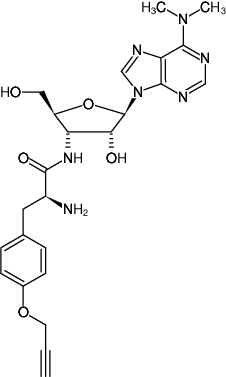Acetate salt
| Cat. No. | Amount | Price (EUR) | Buy / Note |
|---|---|---|---|
| NU-931-05 | 0,5 mg (1 μmol) | 146,36 | Add to Basket/Quote Add to Notepad |
| NU-931-5 | 10 x 0,5 mg (10 μmol) | 730,25 | Add to Basket/Quote Add to Notepad |

For general laboratory use.
Shipping: shipped on gel packs
Storage Conditions: store at -20 °C
Short term exposure (up to 1 week cumulative) to ambient temperature possible.
Shelf Life: 12 months after date of delivery
Molecular Formula: C24H29N7O5 (free acid)
Molecular Weight: 495.53 g/mol
Exact Mass: 495.22 g/mol
CAS#: 1416561-90-4
Purity: ≥ 95 % (HPLC)
Form: solid
Color: colorless to slightly white
Solubility: DMSO, PBS (up to 50 mM tested) pH adjusted to 5.0
Spectroscopic Properties: λmax 275 nm, ε 20.0 L mmol-1 cm-1
Applications:
Protein synthesis monitoring in cell culture and whole organisms[1,2]
Description:
Liu et al.[1] reported a non-radioactive alternative to analyze newly synthesized proteins in cell culture and whole organisms that is based on O-Propargyl-puromycin, an alkyne analog of puromycin.
O-Propargyl-puromycin is cell-permeable and incorporates into the C-terminus of translating polypeptide chains thereby stopping translation.
The resulting truncated C-terminal alkyne labeled proteins can subsequently be detected via Cu(I)-catalyzed click chemistry that offers the choice to introduce a Biotin group (via Azides of Biotin) for subsequent purification tasks or a fluorescent group (via Azides of fluorescent dyes) for subsequent microscopic imaging.
In contrast to Azidohomoalanine (AHA) or Homopropargylgycine (HPG) based non-radioactive methionine analog-approaches, methionine free-medium is not required for O-Propargyl-purmoycin-based monitoring of nascent protein synthesis.
Presolski et al.[4] and Hong et al.[5] provide a general protocol for Cu(I)-catalyzed click chemistry reactions that may be used as a starting point for the set up and optimization of individual assays.
Related products:
BIOZ Product Citations:
Selected References:
[1] Liu et al. (2012) Imaging protein synthesis in cells and tissues with an alkyne analog of puromycin. Proc. Natl. Acad. Sci. USA 109 (2):413.
[2] Signer et al. (2014) Haematopoietic stem cells require a highly regulated protein synthesis rate. Nature 509:49.
[3] Grammel et al. (2013) Chemical reporters for biological discovery. Nat. Chem. Biol. 9 (8):475.
[4] Presolski et al. (2011) Copper-Catalyzed Azide-Alkyne Click Chemistry for Bioconjugation. Current Protocols in Chemical Biology 3:153.
[5] Hong et al. (2011) Analysis and Optimization of Copper-Catalyzed Azide-Alkyne Cycloaddition for Bioconjugation. Angew. Chem. Int. Ed. 48:9879.